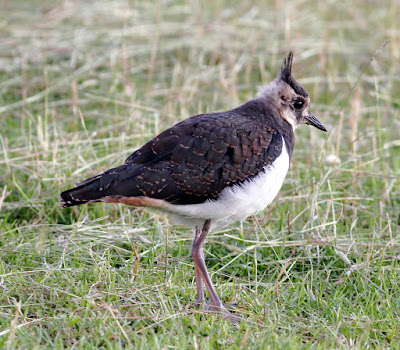I journeyed across the moss and in the half-light saw 2 Barn Owls and at least two Kestrels waiting for dawn to bring breakfast. Singing Song Thrushes seemed to greet me at every hedgerow, garden, spinney and wood. I hope our Song Thrush has had a good year - it certainly sounded like it this morning.
"Click the pics" for a trip to the hills.
Song Thrush
Just for a change I was heading for the Bowland hills today, hoping to get some photographs of upland birds. Unfortunately the light was poor as it often is 1000ft above sea level. Never mind, there was a great selection of birds to see with one or two nice surprises, including brief views of a Ring Ouzel and then later on finding a Snipe nest.
Bowland
Two of the commonest and most obvious species this morning were Pied Wagtails and Meadow Pipits with good numbers of each on almost every stretch of road. There are lots of stone walls and fences for birds to use as lookout posts .There were 10+ Grey Wagtails too with plenty of Willow Warblers, Goldfinches and Lesser Redpolls in roadside trees and plantations. I didn’t do an exact tally but reckoned on 50+ species, not bad for a morning’s work.
Pied Wagtail
Meadow Pipit
The Grey Partridge is pretty much extinct where I live near the coast but maybe they do better up in the hills 15/20 miles away.
Grey Partridge
Most blog readers will know of the saga of Hen Harriers which mysteriously disappear from Bowland and other Pennine Hills localities every year. The same readers will know why the Red Grouse is a favourite bird of those who own the land and shooting rights up here while the Hen Harrier is mostly unloved. Walking miles into the heather uplands might just find a Hen Harrier, but far more likely is a that a Red Grouse will tell a walker to “go-back-go-back” for their own safety. We're in the hills, but that's cotton grass, not snow.
Red Grouse
The most common wader this morning was Oystercatcher with many pairs dotted around the fields and using the stone walls as vantage points. Next came Lapwing with at least a couple of dozen, all of them with well grown flying young, except for a single running youngster, a day or two off flight. Luckily I had my ringing box in the boot for the first Lapwing of the year. This year the species has all but disappeared from lowland haunts, and now clings on by a whisker or less.
Lapwing
Lapwing
Oystercatcher
Curlews were in evidence with birds still displaying but none coming close enough for pictures. Likewise Redshanks, a once common bird in these damp uplands but now like the Curlew, a wader in decline.
I got lucky with a Snipe that I discovered on a gate post. The bird flew off and landed about twenty yards away in a clump of long grass. Undeterred I drove back the same way about thirty minutes later to see the Snipe once again on one of the posts of the gateway. Unconcerned at my presence the Snipe preened a while, took a nap, looked around and generally gave the impression of taking time out. When she eventually fluttered back to the same grassy plot I knew she had a nest. Four eggs - nice one.
Snipe
Snipe
Snipe
Snipe
Other birds today – Mistle Thrush, Song Thrush, Common Sandpiper, Greenfinch, Buzzard, Sparrowhawk, House Martin, Sand Martin, Swallow, Swift, Blackbird, Siskin, Linnet, Woodpigeon, Stock Dove, Collared Dove , Chaffinch, Reed Bunting, Robin, Wren, Dunnock etc.,
A good morning’s birding was had by all.
Linking today to Eileen's Saturday, World Bird Wednesday and Anni's Birding.
Linking today to Eileen's Saturday, World Bird Wednesday and Anni's Birding.





























.jpg)












